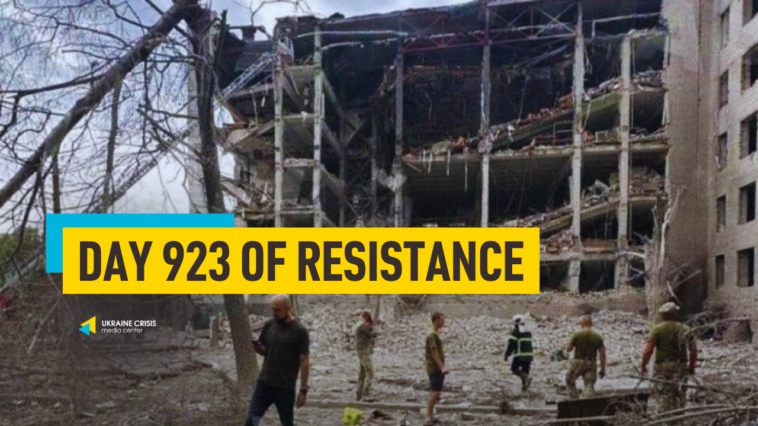A Russian missile strike on a military institute in Poltava kills over 50 people. Two people, including a child, killed in a Russian missile strike on Zaporizhzhia. The U.S. is close to agreeing on long-range missiles for Ukraine.
Russian missile strike on military institute in Poltava kills over 50 people
Two Russian ballistic missiles struck a military institute and nearby hospital in Poltava, killing at least 51 people and wounding over 200 others, Ukrainian officials said Tuesday.
Ukraine’s Defense Ministry said in a statement: “The missiles hit shortly after an air raid alert sounded, when many people were on their way to a bomb shelter. One of the institute’s buildings was partially destroyed, and many people were trapped under the rubble. Thanks to the coordinated work of rescuers and medics, 25 people were rescued, 11 of them were pulled out from under the rubble.”
Ukrainian President Volodymyr Zelenskyi said in a video address that the strike damaged a building of the Military Institute of Communications.
“One of the buildings of the Institute of Communications was partially destroyed. People found themselves under the rubble. Many were saved. More than 180 people were wounded. Unfortunately, there are many casualties. As of now, we know that 41 people were killed,” Zelenskyi said.
He said he ordered “a full and prompt investigation” into what happened.
Russian missile strike on Zaporizhzhia kills two, including a child
Two people — a 38-year-old woman and her 8-year-old son — were killed in a missile strike on a hotel complex in Zaporizhzhia late on Monday. Two other members of the family — the father and a 12-year-old girl — were rescued from under the rubble. Both are hospitalized in serious condition, regional police said. Two more women sought medical assistance due to a suspected concussion.
Head of the Zaporizhzhia regional military administration, Ivan Fedorov said the strike damaged a building. The shock wave and debris caused damage to nearby apartment buildings.
U.S. close to agreeing on long-range missiles for Ukraine
The U.S. is close to an agreement to give Ukraine long-range cruise missiles that could reach deep into Russia, but Kyiv would need to wait several months as the U.S. works through technical issues ahead of any shipment, U.S. officials said, according to Reuters.
The inclusion of Joint Air-to-Surface Standoff Missiles (JASSM) in a weapons package is expected to be announced this autumn, three sources said, though a final decision has not been made.
Sending JASSMs to Ukraine could significantly alter the strategic landscape of the conflict by putting more of Russia in range of powerful, precision-guided munitions, an important concern of the Biden administration, the officials said.
Military analysts have suggested the introduction of JASSMs – which are stealthy and can strike further than most other missiles in Ukraine’s current inventory – could push Russian staging areas and supply depots back by hundreds of miles.
This would severely complicate Russia’s ability to sustain its offensive operations and potentially provide Ukraine with a strategic advantage.
Launching them from points near Ukraine’s northern border with Russia could allow them to hit military installations as far away as the Russian cities of Voronezh and Bryansk. In the south, dropping them near the front lines could enable strikes on airfields or naval facilities in Crimea.
How technology is transforming Ukraine’s agricultural landscape. Ukraine in Flames #658
The Aggeek team presented the results of a large all-Ukrainian study “Digital Agro of Ukraine.” It reveals the level of application of more than 50 digital technologies and solutions and also demonstrates the popularity of brands in segments such as navigation, Farm Management Systems, creation of task maps, precision seeding, and more. The study is very important for the development of Ukrainian agriculture because it is the first time that the use of digital technologies at all stages of agricultural production — from planning to tillage, sowing, harvesting, plant protection, fertilization, and beyond — has been examined. Watch Ukraine in flames #658 to find out about the main directions of using innovations in agriculture, including the most common digital technologies among farmers, market leaders of digital solutions and the use of artificial intelligence in agricultural production.
Guests:
- Oleksandra Prokhorchuk, Director of attracting and developing relationships with medium-sized business clients of Raiffeisen Bank
- Vitaliy Pushkarenko, CEO at FERM
- Oleksandr Prokhatskyi, Digital agronomy business development expert at Syngenta




